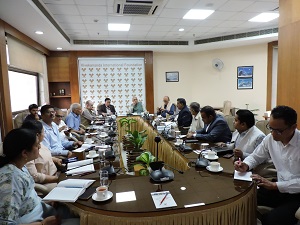On 1 November 2023, VIF organized a Seminar on “Gas and Hydrogen Economy in India.” The seminar was chaired by Dr. Arvind Gupta, Director of VIF, and it was attended by researchers and industry practitioners. Five speakers presented on the role of gas and hydrogen in India’s clean energy transition. They include the following: Mr. J. Maria Thomas, Deputy General Manager (Corporate Strategy Planning and Advocacy), GAIL (India) Limited; Amb. DP Srivastava, Distinguished Fellow, VIF; Dr. VK Saraswat, Member of NITI Aayog; Mr. KR Jyothilal, IAS and Additional Chief Secretary, Government of Kerala; and Mr. Jai Prakash Shivahare, IAS and Managing Director of the Gujarat Urja Vikas Nigam Limited.
Mr. J. Maria Thomas observed that natural gas is an environmentally benign fuel and a suitable stand-in for dirtier fuels like coal and oil. That is because natural gas produces 45% fewer CO2 than coal for power generation, 25% fewer greenhouse gas emissions than diesel or petrol for transportation, and almost no sulfur-dioxide or particulate matter. As such, India has taken proactive steps to increase the share of natural gas in its primary energy mix from the current 5.7% to 15% by 2030. City Gas Distribution (CGD) in particular is a key area of focus. CGD is an interconnected system of underground natural gas pipelines for supplying cleaner cooking fuel like Piped Natural Gas (PNG) and cleaner transportation fuel like Compressed Natural Gas (CNG). Amb. DP Srivastava contended that natural gas is a temporary solution that cannot be relied upon for the long term because of its high costs. Hydrogen too is expensive and it can meet 10% of India’s energy requirement at best. Amb. Srivastava called for nuclear power to be pursued with zest because it is a reliable source of low emissions electricity that is available on demand to complement the leading role of renewables such as wind and solar in the transition to electricity systems with net zero emissions. Meanwhile, Dr. VK Saraswat argued that hydrogen has a vital role to play in India’s clean energy transition and he highlighted two key initiatives undertaken by India namely National Green Hydrogen Mission (NGHM) and Clean Hydrogen Valleys. Under NGHM, India aim to produce 5 million metric tons of green hydrogen by 2030 and become a global hub for the energy. The country also aims to create three Clean Hydrogen Valleys with production capacities of 5000 tons of green hydrogen per year by 2028-2033. The green hydrogen thus produced will be deployed in hard-to-decarbonise sectors such as cement and steel. Dr. Saraswat further insisted that electricity used for green hydrogen production should have low carbon footprint.
Two case studies are also presented. According to Mr. KR Jyothilal, Kerala has conducive environment for clean energy production including high renewable energy potential, numerous reservoirs, forward looking policies, etc. As such, the state aims to generate 5,000 MW of electricity from solar panels that are currently being installed in the reservoir area of its large dams. Also, under the Kochi Green Hydrogen Hub (KGH2), Kerala plans to build green hydrogen plant with a production capacity of 60 tons per day. Kerala also aims to transform its major transport corridors into green economic trade corridors by building cycling tracks, walking track, hydrogen and EV charging stations, etc. along them. Gujarat has also been gearing up to become a hub for green hydrogen. According to Mr. Jai Prakash Shivahare, the state has an installed renewable energy capacity of 21 GW, the second highest in India, and an additional 36 GW solar and 143 GW wind energy potential. These could speed up the production of green hydrogen in the state. Gujarat has also set aside 200,000 hectares of land for green hydrogen projects. Mr. Shivahare also underlined the challenges facing green hydrogen production in India. First is the high cost. Second is the lack of infrastructure such as hydrogen production plants, storage facilities, and transportation networks. And finally there are safety concerns. These challenges, according to Mr. Shivahare, can be overcome through robust policies, public-private partnerships and continuous innovation.
There was a Q & A session after the presentations with the presenters answering the questions on the related issues.










Post new comment